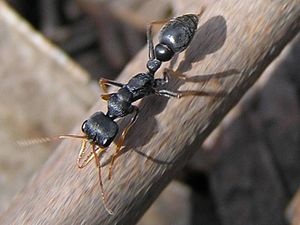Myrmecia pilosula
| Myrmecia pilosula | ||||||||||||
|---|---|---|---|---|---|---|---|---|---|---|---|---|

Myrmecia pilosula |
||||||||||||
| Systematics | ||||||||||||
|
||||||||||||
| Scientific name | ||||||||||||
| Myrmecia pilosula | ||||||||||||
| Smith , 1858 |
Myrmecia pilosula ( English "Jack Jumper", "Hopper Ant" or "Jumper Ant") is a species of ants thatis nativeto Australia . It wasdiscovered and describedby Frederick Smith in Tasmania in 1858.
features
The workers of Myrmecia pilosula are about ten to twelve millimeters long. The body is black and wears yellow-orange jaws. Their antennae have 12 links. The big eyes ensure a good view. Typical of the whole genus Myrmecia are the constrictions at the connection between the trunk ( mesosoma ) and the abdomen ( gaster ). This connection is thereby divided into two segments, petiolus and postpetiolus.
The workers of this species have only one pair of chromosomes . The male ants, like most hymenoptera , have only one simple set of chromosomes ( haploidy ), their genetic material is therefore limited to a single chromosome, which makes them unique among the living beings known to date.
Occurrence
Myrmecia pilosula is native to Australia. Well-known occurrences are in Tasmania, Victoria , New South Wales , Australian Capital Territory and in the southeast of South Australia .
The ants live near the beaches and in the bush and heathland along the coast. They can also be found in meadows and pastures as well as along the roads. Wetlands or rainforests are avoided.
Way of life
Its English name, Hopper Ant, owes its nature to its characteristic jumping movement. When excited, she can make jumps of up to 10 centimeters with the help of her long hind legs. In the event of danger, she can quickly cover a long distance with a series of jumps.
The population of a colony is several hundred to several thousand ants. There can be several queens in the colony, these are mostly closely related to each other. The nests are either hidden under stones or in the bushes and have only one entrance or they are created under anthills that are surrounded by finely granulated stones and have several entrances. These piles can reach a diameter of up to one meter.
Myrmecia pilosula does not move from place to place, but looks for food in a wide area around the colony. It feeds on nectar and plant juices and hunts insects , which it feeds to the brood.
These ants aggressively defend their nest and chase away possible intruders.
The ants are usually not dangerous to humans. A sting with the sting on the back of the body is comparable to that of a bee or wasp . The puncture site swells and the area around the puncture feels warm. A very painful blister forms around the puncture site. About three percent of all people react to a bite with an allergic shock .
Individual evidence
- ↑ Crosland, MWJ, Crozier, RH: Myrmecia pilosula , an ant with only one pair of chromosomes. 1986, accessed July 10, 2008 .
Web links
- Myrmecia pilosula Invasive Ant Threat, Information Sheet, Number 15 (PDF, accessed October 8, 2010)